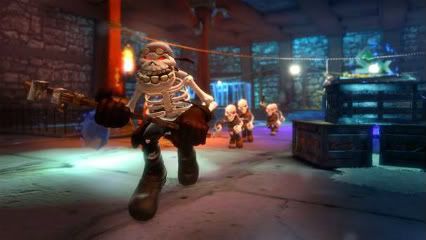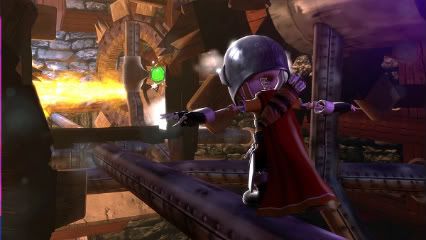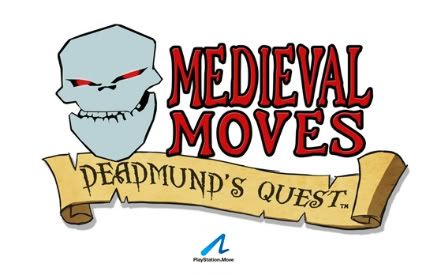- Format: PS3 (PlayStation Move required)
- Unleashed: November 18th (EU), Out Now (US)
- Publisher: Sony Computer Entertainment
- Developer: San Diego Studio/Zindagi Games
- Players: 1 (Story), 2 (Online/offline multiplayer modes)
- Site: Not found
Remember the part of the PlayStation Move tech demo that actually looked kind of interesting? Where the skeletons were fought off with a sword, shield, bow and arrow? Looks like somebody at Sony was rather impressed too; it seems that the idea was made a touch more family friendly, and eventually grew into Medieval Moves.
We’d like to explain the presence of all the animated, dressed, talking skeletons that you’ll be killing; and also how and why your character turns from Edmund the boy prince into – wait for it – Deadmund the boy skeleton (fetch a needle and thread, for our proverbial sides have split). We’d like to explain all that, but that would require watching all the story scenes, which we quite simply could not do. For the first time ever, we even skipped most of a game’s ending. The static pictures look like hastily sketched concept art, the script is dull and peppered with jokes nobody but the writers could possibly find funny, and the acting is consistently half-arsed. The gist is: cursed villagers; “freeing” rather than killing skeletons; magical amulet broken into pieces; evil magician; and so on and so forth.
To be fair, the story isn’t meant to be the main attraction here (though it provides constant interruptions during gameplay). Arguably, the star of the show was always meant to be the controls. Dual wielding Moves is supported but, unwilling and unable to purchase another this time of year, we went for the single-Move control scheme. This works much better than you might expect. Obviously, swinging the controller swings your sword. Hold the Move button to use your shield; mimic the action of pulling an arrow from a quiver on your back to draw your bow (hold the trigger to draw, release to shoot); and, soon enough, use the hold/release mechanic to toss throwing stars from your hip.
The much trumpeted 1:1 motion tracking is in full force here, and is very impressive when it works properly (more on which later). The brief training level has you target the head, limbs and torso of a dummy individually with your sword, which hits home the level of control you have. This hints at a level of sophistication in the combat which, unfortunately, never appears. You’re never required to target certain body parts, and it is in fact extremely tempting to simply swing the controller around wildly in close combat situations. Sadly, this is without fail the most effective tactic against standard enemies.

It's not button bashing, so it's... waggle spamming?
You can’t do this with ranged enemies, which is where skill comes in. The shield does need to be ‘aimed’, in the direction projectiles are coming from. You’ll need to block the attack, then quickly draw your bow to take them out. Fun for the first few levels, but very tired long before the end of the game. Now and again a larger enemy will come along who realises what shields are for. You’ll need to block their attack – again, watching carefully for where the blow will come from – then counter. Again however this gets old very quickly.
The game is by necessity on rails, making it in a way an evolution of the lightgun game. Movement is automatic; you’ll stop in a certain area until things stop trying to kill you, then you move on. The story is surprisingly lengthy given the game’s similarity to the likes of (for example) Time Crisis, and could take several hours to complete. Those hours are, for a few reasons, likely to contain more than their fair share of frustration.
Firstly, the story – which really does grate, for us at least – keeps poking its nose in during gameplay, Regular (and unskippable) pauses for Deadmund to talk with his ancestor are minor annoyances at best; major annoyances at worst, namely if you repeatedly have to restart a checkpoint which begins with one of these chatty segments. Failure is unlikely on the easiest difficulty, which for most of the game is almost patronisingly easy. On the harder difficulties however, the cheap tactics introduced to slow you down (mainly combining multiple ranged enemies, usually using cover, with melee enemies and extending the gaps between checkpoints) in the final quarter of the game are particularly noticeable. From the penultimate boss onwards, the difficulty for those looking for a challenge is quite frankly perverse.

How can we forget the obligatory balancing sections? No, seriously, how can we forget them; any ideas?
The nature of the tech sometimes poses problems of its own. The last weapon we haven’t mentioned is dynamite, which we found tricky to aim when throwing simply because we didn’t seem to have enough space between us and the camera (we usually had 5-6 feet) for the Eye to track a quick and sweeping throwing gesture. Of more concern was what we still can’t decide is a bug, or another symptom of the camera demanding a huge playing space. In the second half of the game, we would regularly find that when drawing the bow, it appeared on-screen but the aiming reticule did not, meaning we couldn’t shoot. We’ve never experienced similar issues with Wii games.
This may be aimed primarily at younger gamers, but the co-ordination required for basic play – combined with the quick reactions and ability to rapidly swap between weapons demanded as you progress – means that the younger the player, the faster they’ll hit a wall of frustration long before the end comes. It’s a fair and unique experience in small chunks, but extended play is likely to lead to boredom.
There are a few multiplayer modes, but absolutely no combat games that might have injected an immediate dose of dumb fun into the disc. What you get instead are variations on surviving against waves of enemies, playing with or against other players for points. The best thing about multiplayer is that it doesn’t feature the miserable QTEs (which immediately kill the immersion) shoehorned into the story now and again. That’s Medieval Moves; you need to count your blessings to squeeze the most enjoyment out of it.


















Comments